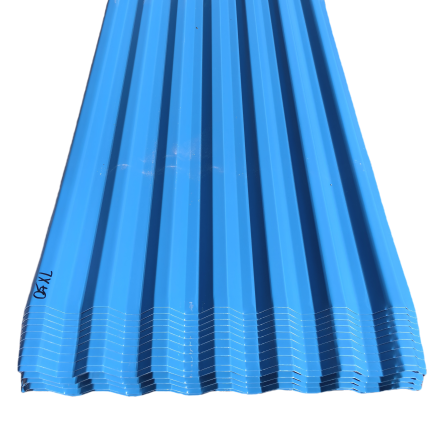Οι χάλυβες πλάκες παίζουν κρίσιμο ρόλο σε κτίρια με χάλυβες κατασκευές. Λειτουργούν ως θεμελιώδη στοιχεία, εξασφαλίζοντας τη σταθερότητα και τη δύναμη ολόκληρης της δομής. Αυτές οι πλάκες διανέμουν φορτία αποτελεσματικά, αποτρέποντας τη συγκέντρωση τάσεων σε συγκεκριμένα σημεία. Ο ανθεκτικός σχεδιασμός τους ενισχύει τη διάρκεια ζωής των κτιρίων, επιτρέποντάς τους να αντέχουν σε βαριά χρήση και περιβαλλοντικές προκλήσεις. Οι λειτουργίες των χάλυβων πλακών επεκτείνονται επίσης στην υποστήριξη καινοτόμων αρχιτεκτονικών σχεδίων, προσφέροντας ευελιξία για τις σύγχρονες ανάγκες κατασκευής. Η ευχρηστία και η αξιοπιστία τους τις καθιστούν αναντικατάστατες στη δημιουργία ασφαλών και μακροχρόνιων δομών.
Δομική Υποστήριξη και Κατανομή Φορτίου
Οι χάλυβες πλάκες λειτουργούν ως κρίσιμα στοιχεία σε κτίρια με χάλυβες δομές, εξασφαλίζοντας σταθερότητα και αντοχή. Η ικανότητά τους να αντέχουν σε τεράστια πίεση τις καθιστά αναντικατάστατες στη σύγχρονη κατασκευή. Κατανοώντας τις συγκεκριμένες λειτουργίες των χάλυβων πλακών, μπορεί κανείς να εκτιμήσει τον ρόλο τους στη δημιουργία ασφαλών και ανθεκτικών δομών.
Λειτουργίες των χάλυβων πλακών στην αντοχή σε βαριά φορτία
Οι χάλυβες πλάκες διαπρέπουν στην αντοχή σε βαριά φορτία λόγω της υψηλής εφελκυστικής τους αντοχής και ανθεκτικότητας. Οι μηχανικοί βασίζονται σε αυτές τις πλάκες για να υποστηρίξουν σημαντικό βάρος χωρίς να διακυβεύεται η δομική ακεραιότητα των κτιρίων. Στην κατασκευή, συχνά χρησιμοποιούν χάλυβες πλάκες ως βάσεις, οι οποίες λειτουργούν ως θεμέλιο για χάλυβες στήλες. Αυτές οι πλάκες διανέμουν το φορτίο από τις στήλες ομοιόμορφα στη σκυρόδετη βάση, αποτρέποντας τη συγκέντρωση πίεσης. Αυτή η ικανότητα εξασφαλίζει ότι τα κτίρια μπορούν να αντέξουν βαριά χρήση, όπως σε βιομηχανικές εγκαταστάσεις ή μεγάλους εμπορικούς χώρους.
Ρόλος στη διανομή βάρους σε δοκούς και στήλες
Οι λειτουργίες των χάλκινων πλακών εκτείνονται πέρα από την αντοχή φορτίου. Παίζουν έναν ζωτικό ρόλο στη διανομή του βάρους σε δοκούς και στήλες. Όταν ενσωματώνονται στο πλαίσιο, οι χάλκινες πλάκες βοηθούν στη διάδοση του φορτίου ομοιόμορφα, μειώνοντας τον κίνδυνο δομικής αποτυχίας. Για παράδειγμα, οι πλάκες γούστας συνδέουν δοκούς και στήλες, εξασφαλίζοντας σταθερότητα σε κρίσιμες διασταυρώσεις. Αυτή η διανομή ελαχιστοποιεί την πίεση σε μεμονωμένα στοιχεία, ενισχύοντας τη συνολική ανθεκτικότητα της δομής. Με αυτόν τον τρόπο, οι χάλκινες πλάκες συμβάλλουν στη μακροχρόνια διάρκεια και την ασφάλεια των κτιρίων από χάλυβα.
Εφαρμογές σε ψηλά κτίρια και μεγάλη υποδομή
Οι πλάκες χάλυβας βρίσκουν εκτεταμένες εφαρμογές σε υψηλά κτίρια και μεγάλα έργα υποδομών. Σε δάφια, παρέχουν την απαραίτητη υποστήριξη για να αντιμετωπίζουν κατακόρυφες και οριζόντιες φορτίες που προκαλούνται από τον ανέμο και τη σεισμική δραστηριότητα. Η χρήση τους σε γέφυρες και βιομηχανικά εγκαταστήματα επισημαίνει την πολυτέλειά τους. Για παράδειγμα, οι πλάκες χάλυβας ενισχύουν τα δάφια των γεφυρών, εξασφαλίζοντας ότι μπορούν να φέρουν βαριές φορτίες κυκλοφορίας. Σε υψηλά κτίρια, επιτρέπουν την κατασκευή ανοιχτών χώρων μειώνοντας την ανάγκη για υπερβολικά εσωτερικά κολόννια. Αυτή η ευελιξία επιτρέπει στους αρχιτέκτονες να σχεδιάζουν καινοτόμους και λειτουργικούς χώρους ενώ διατηρούν τη δομική ακεραιότητα.
"Οι χάλυβες πλάκες είναι η ραχοκοκαλιά της σύγχρονης κατασκευής, επιτρέποντας στους αρχιτέκτονες και τους μηχανικούς να επεκτείνουν τα όρια του σχεδιασμού και της λειτουργικότητας."
Οι λειτουργίες των χάλυβων πλακών σε αυτές τις εφαρμογές αποδεικνύουν τη σημασία τους στη δημιουργία ανθεκτικών και αποδοτικών δομών. Η ικανότητά τους να αντέχουν βαριά φορτία, να διανέμουν το βάρος και να προσαρμόζονται σε διάφορες αρχιτεκτονικές ανάγκες διασφαλίζει τη συνεχιζόμενη σημασία τους στη βιομηχανία κατασκευών.
Ενίσχυση και Σταθερότητα
Οι χάλυβες πλάκες παίζουν καθοριστικό ρόλο στην ενίσχυση των κτιρίων με χάλυβες δομές και στην εξασφάλιση της σταθερότητάς τους. Η ικανότητά τους να ενισχύουν τις συνδέσεις, να αποτρέπουν τη δομική παραμόρφωση και να βελτιώνουν την αντοχή στους σεισμούς τις καθιστά αναγκαίες στη σύγχρονη κατασκευή.
Ενίσχυση των συνδέσεων σε χάλυβες δομές
Οι χάλυβες πλάκες ενισχύουν τη δύναμη των συνδέσεων σε χάλυβες σκελετούς. Οι μηχανικοί τις χρησιμοποιούν για να συνδέσουν ασφαλώς δοκούς, στήλες και άλλα δομικά στοιχεία. Για παράδειγμα, οι πλάκες σύνδεσης συνδέουν δύο τμήματα μιας δοκού ή στήλης, εξασφαλίζοντας μια ομαλή μεταφορά φορτίων. Οι πλάκες γάστρας, μια άλλη κοινή εφαρμογή, παρέχουν επιπλέον στήριξη σε αρμούς όπου συναντώνται πολλαπλά μέλη. Αυτές οι πλάκες αποτρέπουν τη δημιουργία αδύνατων σημείων στη δομή, μειώνοντας τον κίνδυνο αποτυχίας υπό πίεση. Ενισχύοντας αυτές τις κρίσιμες συνδέσεις, οι χάλυβες πλάκες συμβάλλουν στη συνολική σταθερότητα και ασφάλεια του κτιρίου.
Αποτροπή παραμόρφωσης, κάμψης και πτυχών
Οι λειτουργίες των χάλκινων πλακών επεκτείνονται στην πρόληψη παραμόρφωσης, κάμψης και πτύχωσης σε χάλκινες κατασκευές. Η υψηλή αντοχή σε εφελκυσμό επιτρέπει σε αυτές τις πλάκες να αντιστέκονται σε δυνάμεις που θα μπορούσαν να διακυβεύσουν την ακεραιότητα του κτιρίου. Σε περιοχές που υπόκεινται σε βαριά φορτία ή δυναμικές δυνάμεις, όπως βιομηχανικές εγκαταστάσεις ή γέφυρες, οι χάλκινες πλάκες λειτουργούν ως ενισχύσεις. Διανέμουν την πίεση ομοιόμορφα σε όλη τη δομή, ελαχιστοποιώντας τον κίνδυνο τοπικής ζημιάς. Οι μηχανικοί συχνά ενσωματώνουν πλάκες ενίσχυσης σε δοκούς και στήλες για να διατηρήσουν το σχήμα τους υπό πίεση. Αυτή η προσέγγιση διασφαλίζει ότι η δομή παραμένει σταθερή και λειτουργική με την πάροδο του χρόνου.
Χρήση χάλκινων πλακών σε σεισμικά ανθεκτικά σχέδια
Οι χάλυβες πλάκες είναι αναπόσπαστο μέρος των σχεδίων ανθεκτικών στους σεισμούς. Η ικανότητά τους να απορροφούν και να διαχέουν ενέργεια κατά τη διάρκεια σεισμικών γεγονότων βοηθά στην προστασία των κτιρίων από κατάρρευση. Τα συστήματα απομόνωσης βάσης συχνά περιλαμβάνουν χάλυβες πλάκες για να μειώσουν τη μεταφορά της κίνησης του εδάφους στη δομή. Οι τοίχοι διάτμησης ενισχυμένοι με χάλυβες πλάκες ενισχύουν τη πλευρική σταθερότητα, αποτρέποντας την υπερβολική κίνηση κατά τη διάρκεια σεισμών. Επιπλέον, οι μηχανικοί χρησιμοποιούν χάλυβες πλάκες για να ενισχύσουν τις αρθρώσεις και τις συνδέσεις, διασφαλίζοντας ότι παραμένουν άθικτες υπό ακραίες συνθήκες. Αυτές οι εφαρμογές αναδεικνύουν τη σημασία των χάλυβων πλακών στη δημιουργία δομών που μπορούν να αντέξουν φυσικές καταστροφές.
"Η ενσωμάτωση χάλυβων πλακών στα δομικά σχέδια διασφαλίζει την ανθεκτικότητα απέναντι σε καθημερινές πιέσεις και εξαιρετικά γεγονότα."
Η ενίσχυση και η σταθερότητα που παρέχονται από τις χάλκινες πλάκες είναι απαραίτητες για τη μακροχρόνια διάρκεια και την ασφάλεια των κτιρίων με χάλυβα. Η ικανότητά τους να ενισχύουν τις συνδέσεις, να αντιστέκονται στη παραμόρφωση και να βελτιώνουν την αντοχή στους σεισμούς υπογραμμίζει την αξία τους στις σύγχρονες πρακτικές κατασκευής.
Ευελιξία στο Σχεδιασμό και την Προσαρμογή
Οι χάλκινες πλάκες προσφέρουν απαράμιλλη ευελιξία στον αρχιτεκτονικό σχεδιασμό και την προσαρμογή. Η προσαρμοστικότητά τους επιτρέπει στους αρχιτέκτονες και τους μηχανικούς να εξερευνούν δημιουργικές δυνατότητες διατηρώντας παράλληλα την δομική ακεραιότητα. Αυτή η ευχέρεια έχει καταστήσει τις χάλκινες πλάκες προτιμώμενη επιλογή στη σύγχρονη κατασκευή.
Ευχέρεια των χάλκινων πλακών σε αρχιτεκτονικές εφαρμογές
Οι χάλυβες πλάκες παρέχουν στους αρχιτέκτονες την ελευθερία να σχεδιάζουν δομές που συνδυάζουν τη λειτουργικότητα και την αισθητική. Η ικανότητά τους να υποστηρίζουν μεγάλες διαστάσεις χωρίς υπερβολικούς εσωτερικούς στήλους επιτρέπει τη δημιουργία ανοιχτών και ευρύχωρων εσωτερικών χώρων. Αυτή η δυνατότητα αποδεικνύεται ουσιώδης σε εμπορικά κτίρια, μουσεία και αεροδρόμια όπου απαιτούνται εκτενή σχέδια. Οι χάλυβες πλάκες συμβάλλουν επίσης σε μοναδικούς εξωτερικούς σχεδιασμούς, όπως καμπύλες προσόψεις ή περίπλοκα γεωμετρικά μοτίβα. Αυτές οι εφαρμογές αποδεικνύουν πώς οι χάλυβες πλάκες ενισχύουν τόσο την οπτική απήχηση όσο και την πρακτικότητα των κτιρίων.
"Η ευελιξία των χάλυβων πλακών δίνει τη δυνατότητα στους αρχιτέκτονες να μετατρέπουν φιλόδοξες έννοιες σε πραγματικότητα."
Επιπλέον, οι χάλυβες πλάκες χρησιμεύουν ως διακοσμητικά στοιχεία στην αρχιτεκτονική βιομηχανικού στυλ. Η κομψή και σύγχρονη εμφάνισή τους συμπληρώνει άλλα υλικά όπως το γυαλί και το σκυρόδεμα, δημιουργώντας μια σύγχρονη αισθητική. Αυτή η προσαρμοστικότητα διασφαλίζει ότι οι χάλυβες πλάκες παραμένουν σχετικές σε διάφορους αρχιτεκτονικούς στυλ.
Προσαρμογή για συγκεκριμένες απαιτήσεις σχεδίασης
Οι χάλυβες πλάκες μπορούν να προσαρμοστούν για να καλύψουν τις μοναδικές απαιτήσεις οποιουδήποτε έργου. Οι μηχανικοί μπορούν να κόψουν, να σχηματίσουν και να συγκολλήσουν αυτές τις πλάκες σε διάφορα μεγέθη και σχήματα, διασφαλίζοντας ότι ταιριάζουν άψογα στο σχέδιο. Για παράδειγμα, οι πλάκες χάλυβα που έχουν κοπεί κατά παραγγελία χρησιμοποιούνται συχνά σε γέφυρες για να καλύψουν συγκεκριμένες απαιτήσεις φορτίου. Σε ψηλά κτίρια, οι προσαρμοσμένες πλάκες χάλυβα ενισχύουν κρίσιμες περιοχές, όπως οι αρμοί και οι συνδέσεις, για να βελτιώσουν τη σταθερότητα.
Η δυνατότητα τροποποίησης των πλάκων χάλυβα επεκτείνεται και στην πάχος και τις επιφανειακές επεξεργασίες. Μπορούν να εφαρμοστούν επισ coatings για να βελτιωθεί η αντοχή στη διάβρωση ή να επιτευχθεί μια επιθυμητή φινίρισμα. Αυτό το επίπεδο προσαρμογής επιτρέπει στις πλάκες χάλυβα να προσαρμόζονται σε διαφορετικά περιβάλλοντα, από παράκτιες περιοχές έως βιομηχανικές ζώνες. Με την προσαρμογή των πλάκων χάλυβα στις συγκεκριμένες ανάγκες, οι επαγγελματίες κατασκευών μπορούν να βελτιστοποιήσουν τόσο την απόδοση όσο και την αισθητική.
Ενσωμάτωση με άλλα υλικά όπως γυαλί και σκυρόδεμα
Οι χάλυβδινες πλάκες ενσωματώνονται άψογα με υλικά όπως το γυαλί και το σκυρόδεμα, επιτρέποντας καινοτόμες τεχνικές κατασκευής. Στα συστήματα τοίχων κουρτίνας, οι χάλυβδινες πλάκες παρέχουν την απαραίτητη στήριξη για μεγάλες γυάλινες επιφάνειες, δημιουργώντας διαφανείς προσόψεις που μεγιστοποιούν το φυσικό φως. Αυτή η ενσωμάτωση ενισχύει την ενεργειακή απόδοση και μειώνει την ανάγκη για τεχνητό φωτισμό.
Στην σύνθετη κατασκευή, οι χάλυβδινες πλάκες συνεργάζονται με το σκυρόδεμα για να σχηματίσουν υβριδικές δομές. Για παράδειγμα, οι χάλυβδινες πλάκες ενισχύουν τις πλάκες σκυροδέματος σε δάπεδα και γέφυρες, συνδυάζοντας τη δύναμη του χάλυβα με τις συμπιεστικές ιδιότητες του σκυροδέματος. Αυτή η συνεργασία έχει ως αποτέλεσμα ελαφρύτερες αλλά πιο ισχυρές δομές, μειώνοντας τη χρήση υλικών και το κόστος κατασκευής.
Οι λειτουργίες των χάλκινων πλακών εκτείνονται πέρα από τη δομική υποστήριξη. Η συμβατότητά τους με άλλα υλικά επιτρέπει στους αρχιτέκτονες να πειραματίζονται με υφές, χρώματα και φινιρίσματα, επιτυγχάνοντας μοναδικά σχέδια. Αυτή η ενσωμάτωση υπογραμμίζει τη σημασία των χάλκινων πλακών στη σύγχρονη κατασκευή, όπου η καινοτομία και η αποδοτικότητα πηγαίνουν χέρι-χέρι.
Αρμόδια και ανθεκτικά σε περιβαλλοντικούς παράγοντες
Αντίσταση στη διάβρωση μέσω προστατευτικών επιστρώσεων
Οι χάλκινες πλάκες επιδεικνύουν εξαιρετική αντοχή, ιδιαίτερα όταν έχουν υποστεί επεξεργασία με προστατευτικές επιστρώσεις. Οι μηχανικοί συχνά εφαρμόζουν επιστρώσεις όπως η γαλβανίωση ή η εποξική ρητίνη για να προστατεύσουν τις χάλκινες πλάκες από τη διάβρωση. Αυτές οι θεραπείες δημιουργούν ένα φράγμα που εμποδίζει την υγρασία και το οξυγόνο να φτάσουν στην επιφάνεια του χάλυβα, μειώνοντας τον κίνδυνο σχηματισμού σκουριάς. Σε παράκτιες περιοχές ή βιομηχανικές ζώνες, όπου η έκθεση σε θαλασσινό νερό ή χημικά είναι συχνή, αυτές οι επιστρώσεις επεκτείνουν σημαντικά τη διάρκεια ζωής των χάλκινων πλακών.
"Οι προστατευτικές επιστρώσεις διασφαλίζουν ότι οι χάλκινες πλάκες διατηρούν την δομική τους ακεραιότητα, ακόμη και στις πιο σκληρές συνθήκες."
Η τακτική συντήρηση και η επαναφορά των επιστρώσεων ενισχύουν περαιτέρω την αντοχή στη διάβρωση. Αυτή η προληπτική προσέγγιση ελαχιστοποιεί το κόστος επισκευών και εξασφαλίζει τη μακροχρόνια αξιοπιστία των κτιρίων με σιδηρές κατασκευές.
Αντοχή στη φωτιά και τις καιρικές συνθήκες σε ακραίες καταστάσεις
Οι σιδηρές πλάκες επιδεικνύουν αξιοσημείωτη αντοχή στη φωτιά και τις δυσμενείς καιρικές συνθήκες. Το υψηλό τους σημείο τήξης τους επιτρέπει να αντέχουν σε ακραία θερμότητα χωρίς να χάνουν τη δομική τους ακεραιότητα. Οι μηχανικοί συχνά ενσωματώνουν πυράντοχες επιστρώσεις ή επεκτεινόμενα χρώματα για να ενισχύσουν αυτή την ιδιότητα. Αυτά τα υλικά επεκτείνονται όταν εκτίθενται σε θερμότητα, σχηματίζοντας ένα μονωτικό στρώμα που καθυστερεί τη διάδοση της φωτιάς. Αυτή η δυνατότητα παρέχει κρίσιμο χρόνο για εκκένωση και μειώνει τη ζημιά στη δομή.
Εκτός από την αντοχή στη φωτιά, οι χάλυβες πλάκες αντέχουν σε σκληρές καιρικές συνθήκες, συμπεριλαμβανομένων των έντονων βροχών, του χιονιού και των ισχυρών ανέμων. Η ανθεκτική τους σύνθεση αντιστέκεται σε παραμορφώσεις, ρωγμές ή φθορά που προκαλούνται από τις διακυμάνσεις της θερμοκρασίας. Αυτή η ανθεκτικότητα καθιστά τις χάλυβες πλάκες μια αξιόπιστη επιλογή για κτίρια σε περιοχές που είναι επιρρεπείς σε σοβαρά καιρικά φαινόμενα.
Μακροχρόνια διάρκεια των χάλυβων πλακών σε δύσκολα περιβάλλοντα
Η μακροχρόνια διάρκεια των χάλυβων πλακών τις ξεχωρίζει ως προτιμώμενο υλικό στην κατασκευή. Η ικανότητά τους να αντιστέκονται στη φθορά εξασφαλίζει ότι παραμένουν λειτουργικές για δεκαετίες, ακόμη και σε δύσκολα περιβάλλοντα. Για παράδειγμα, σε βιομηχανικές εγκαταστάσεις, οι χάλυβες πλάκες αντέχουν σε συνεχή έκθεση σε δονήσεις βαρέων μηχανημάτων και χημικές διαρροές. Σε γέφυρες, αντέχουν σε συνεχείς φορτίσεις κυκλοφορίας και περιβαλλοντικούς στρεσογόνους παράγοντες χωρίς να διακυβεύεται η απόδοση.
"Η ανθεκτικότητα των χάλυβων πλακών συμβάλλει στη βιωσιμότητα των κατασκευαστικών έργων μειώνοντας την ανάγκη για συχνές αντικαταστάσεις."
Η σωστή σχεδίαση, εγκατάσταση και συντήρηση ενισχύουν περαιτέρω τη διάρκεια ζωής των χάλκινων πλακών. Επενδύοντας σε υλικά υψηλής ποιότητας και προστατευτικά μέτρα, οι επαγγελματίες κατασκευών διασφαλίζουν ότι τα κτίρια με χάλυβα παραμένουν ασφαλή και αποδοτικά με την πάροδο του χρόνου. Αυτή η ανθεκτικότητα υπογραμμίζει την αξία των χάλκινων πλακών στη δημιουργία δομών που αντέχουν στη δοκιμασία του χρόνου.
Ρόλος στη Συγκροτημένη και Προκατασκευασμένη Κατασκευή
Απλοποίηση των διαδικασιών κατασκευής με προκατασκευασμένα στοιχεία
Οι χάλυβες πλάκες παίζουν σημαντικό ρόλο στην αρθρωτή και προ-κατασκευασμένη κατασκευή, απλοποιώντας τις διαδικασίες οικοδόμησης. Οι κατασκευαστές προ-κόβουν και προ-συναρμολογούν τις χάλυβες πλάκες σε εξαρτήματα, μειώνοντας την ανάγκη για εκτενή κατασκευή στον χώρο. Αυτή η προσέγγιση ελαχιστοποιεί τις εργασίες που απαιτούν πολλή εργασία στα εργοτάξια, επιτρέποντας στους εργαζόμενους να επικεντρωθούν στην αποδοτική συναρμολόγηση. Τα προ-κατασκευασμένα εξαρτήματα χάλυβα διασφαλίζουν επίσης συνεπή ποιότητα, καθώς παράγονται υπό ελεγχόμενες συνθήκες εργοστασίου. Αυτή η συνέπεια ενισχύει την δομική ακεραιότητα των κτιρίων και μειώνει την πιθανότητα λαθών κατά την εγκατάσταση.
Η χρήση προ-κατασκευασμένων χάλυβων πλακών επιταχύνει τα χρονοδιαγράμματα των έργων. Οι ομάδες κατασκευής μπορούν να συναρμολογήσουν γρήγορα τα μοντέλα, επιτρέποντας ταχύτερη ολοκλήρωση των έργων. Για παράδειγμα, σε τομείς υψηλής ζήτησης όπως η κατοικία ή οι εμπορικοί χώροι, αυτή η ταχύτητα αποδεικνύεται ανεκτίμητη. Απλοποιώντας τις διαδικασίες κατασκευής, οι χάλυβες πλάκες συμβάλλουν σε οικονομικές και χρονο-αποτελεσματικές πρακτικές οικοδόμησης.
"Τα προ-κατασκευασμένα στοιχεία από χάλυβα επαναστατούν την κατασκευή συνδυάζοντας την ακρίβεια, την αποδοτικότητα και την αξιοπιστία."
Ενίσχυση της βιωσιμότητας μέσω της ανακυκλωσιμότητας
Οι πλάκες χάλυβα υποστηρίζουν τη βιωσιμότητα στην κατασκευή λόγω της ανακυκλωσιμότητάς τους. Σε αντίθεση με πολλά άλλα υλικά, ο χάλυβας διατηρεί τις ιδιότητές του ακόμη και μετά από πολλές διαδικασίες ανακύκλωσης. Αυτή η χαρακτηριστική ιδιότητα τον καθιστά φιλικό προς το περιβάλλον επιλογή για τη modular και προ-κατασκευασμένη κατασκευή. Οι κατασκευαστές μπορούν να επαναχρησιμοποιούν πλάκες χάλυβα από αποσυρθέντες δομές, μειώνοντας τη ζήτηση για πρώτες ύλες. Αυτή η πρακτική διατηρεί τους φυσικούς πόρους και ελαχιστοποιεί τον περιβαλλοντικό αντίκτυπο των κατασκευαστικών δραστηριοτήτων.
Η ανακύκλωση των χάλυβδινων πλακών μειώνει επίσης την παραγωγή αποβλήτων. Αντί να απορρίπτουν παλιά ή αχρησιμοποίητα υλικά, οι κατασκευαστές μπορούν να τα λιώσουν και να τα επαναχρησιμοποιήσουν σε νέα εξαρτήματα. Αυτό το κλειστό σύστημα ευθυγραμμίζεται με τους στόχους βιώσιμης κατασκευής, προάγοντας την αποδοτικότητα των πόρων και μειώνοντας τις συνεισφορές σε χωματερές. Δίνοντας προτεραιότητα στην ανακυκλωσιμότητα, οι χάλυβδινες πλάκες βοηθούν τη βιομηχανία κατασκευών να προχωρήσει προς πιο φιλικές προς το περιβάλλον πρακτικές.
Μείωση αποβλήτων υλικών και χρόνου κατασκευής
Οι χάλυβδινες πλάκες συμβάλλουν στη μείωση των αποβλήτων επιτρέποντας την ακριβή χρήση υλικών. Οι προηγμένες τεχνικές κατασκευής επιτρέπουν στους μηχανικούς να κόβουν τις χάλυβδινες πλάκες σε ακριβείς διαστάσεις, ελαχιστοποιώντας τα υπολείμματα και τα σκουπίδια. Αυτή η ακρίβεια διασφαλίζει ότι κάθε κομμάτι έχει έναν σκοπό, μειώνοντας τα περιττά απόβλητα. Στην αρθρωτή κατασκευή, τα προ-κατασκευασμένα εξαρτήματα χάλυβδινων πλακών βελτιστοποιούν περαιτέρω τη χρήση υλικών. Οι εργοστάσια παράγουν μόνο τις απαιτούμενες ποσότητες, αποφεύγοντας την υπερπαραγωγή και την υπερβολική αποθήκευση.
Τα οφέλη εξοικονόμησης χρόνου από τις χάλυβες πλάκες επεκτείνονται πέρα από την κατασκευή. Η προ-κατασκευασμένη φύση τους απλοποιεί τη συναρμολόγηση στον χώρο, μειώνοντας τις καθυστερήσεις που προκαλούνται από πολύπλοκες εγκαταστάσεις. Οι εργάτες μπορούν να ολοκληρώσουν τα έργα γρηγορότερα, πληρώντας αυστηρές προθεσμίες χωρίς να θυσιάζουν την ποιότητα. Αυτή η αποδοτικότητα μειώνει το κόστος εργασίας και ενισχύει τη συνολική παραγωγικότητα.
"Οι χάλυβες πλάκες αποτελούν παράδειγμα αποδοτικότητας στην κατασκευή μειώνοντας τα απόβλητα, εξοικονομώντας χρόνο και προσφέροντας ανώτερη απόδοση."
Ενσωματώνοντας τις χάλυβες πλάκες σε αρθρωτή και προ-κατασκευασμένη κατασκευή, οι κατασκευαστές επιτυγχάνουν μια ισορροπία μεταξύ βιωσιμότητας, αποδοτικότητας και καινοτομίας. Αυτά τα πλεονεκτήματα τοποθετούν τις χάλυβες πλάκες ως θεμέλιο των σύγχρονων πρακτικών κατασκευής.
Οι χάλυβδινες πλάκες παίζουν ζωτικό ρόλο στην εξασφάλιση της δομικής ακεραιότητας και σταθερότητας των κτιρίων με χάλυβδινες κατασκευές. Η ικανότητά τους να αντέχουν βαριά φορτία, να αντιστέκονται σε περιβαλλοντικές προκλήσεις και να προσαρμόζονται σε ποικίλους αρχιτεκτονικούς σχεδιασμούς υπογραμμίζει τη σημασία τους στη σύγχρονη κατασκευή. Αυτές οι πλάκες ενισχύουν την αποδοτικότητα υποστηρίζοντας καινοτόμες πρακτικές κατασκευής ενώ διατηρούν τη διάρκεια. Καθώς οι μέθοδοι κατασκευής εξελίσσονται, οι λειτουργίες των χάλυβδινων πλακών θα συνεχίσουν να προωθούν βιώσιμες και προοδευτικές λύσεις. Η ευελιξία και η αξιοπιστία τους εδραιώνουν τη θέση τους ως αναπόσπαστα στοιχεία στη δημιουργία ασφαλών και ανθεκτικών δομών.

 EN
EN







































